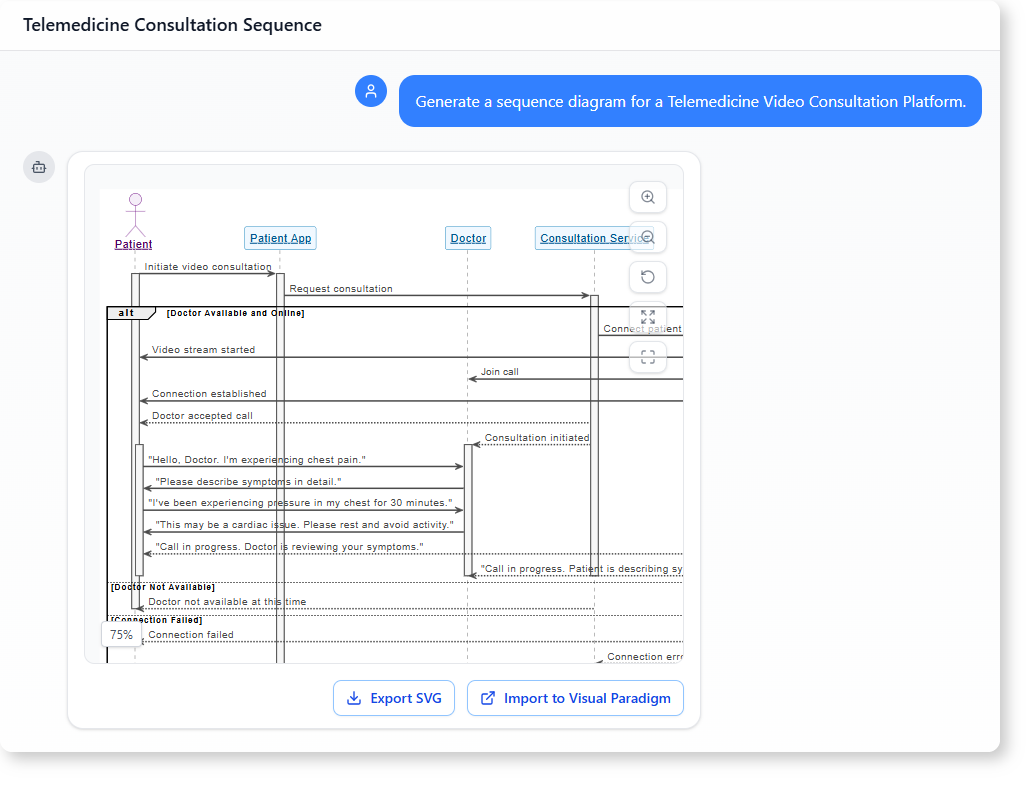Now Reading: How AI-Powered Modeling Software Builds a Smart Telemedicine Consultation Flow
-
01
How AI-Powered Modeling Software Builds a Smart Telemedicine Consultation Flow
How AI-Powered Modeling Software Builds a Smart Telemedicine Consultation Flow
How AI-Powered Modeling Software Builds a Smart Telemedicine Consultation Flow
Imagine a patient experiencing chest pain, needing immediate medical advice. They open their app, tap a button, and start a video call with a doctor. Behind the scenes, a series of interactions happen — from app requests to video stream initiation, symptom exchange, and decision-making. This isn’t magic. It’s a carefully designed flow.
With the right AI-powered modeling software, this flow can be clearly visualized, understood, and improved — without needing deep technical knowledge.

Why a Telemedicine Platform Needs Clear Interaction Mapping
A telemedicine video consultation platform isn’t just about video. It’s about trust, timing, and clarity. Patients need to feel safe and heard. Doctors need to start the session with relevant data.
Without a clear picture of how each step connects, the platform risks delays, missed diagnoses, or poor user experience. That’s where AI-powered modeling software comes in.
This tool helps translate natural language into a visual sequence diagram — showing every interaction, decision, and outcome. It doesn’t just show what happens. It shows when, who is involved, and what choices are made.
The User’s Journey: From Prompt to Flow
A healthcare app developer was building a telemedicine platform. They needed to understand the full patient-doctor interaction — especially during the first minutes of a call.
They didn’t start with code or flowcharts. Instead, they began with a simple prompt:
“Generate a sequence diagram for a Telemedicine Video Consultation Platform.”
The AI-powered modeling software responded by generating a full sequence diagram — showing the patient, doctor, app, and service layers working together.
Next, they asked a follow-up:
“Highlight the critical interactions and decision points in this sequence diagram.”
The tool didn’t just show the flow — it identified the moments that matter most. These were the points where delays or failures could impact patient outcomes.
What the AI-Powered Modeling Software Delivers
The resulting sequence diagram clearly breaks down the entire patient-doctor connection.
- The process starts with the patient initiating the call through the patient app.
- The app requests a consultation from the backend service.
- The system checks if the doctor is available — a key decision point.
- If the doctor is online, the video platform connects both parties.
- The patient shares symptoms, and the doctor responds with clinical guidance.
- If the doctor isn’t available, the system gives a clear message.
- If the connection fails, the error is reported immediately.
What makes this powerful is that each interaction is labeled, and critical moments — like doctor availability, connection status, and symptom entry — are clearly marked.
The tool identifies the decision points that can impact patient experience:
- Doctor availability check
- Connection success or failure
- Symptom description by patient
These are not just steps. They are control points where the system must react — and where user experience depends on clarity and speed.
Why This is the Future of AI-Powered Modeling Software
Traditional modeling tools require technical skills and long design cycles. This new approach changes the game.
With AI-powered modeling software, anyone can describe a system — even without knowing software architecture. The AI interprets the prompt and builds a clear, accurate flow.
It’s not about generating code. It’s about creating understanding.
This is especially valuable in healthcare, where workflows must be safe, responsive, and human-centered.
How It Helps in Real-World Design
Designers and product teams use this method to:
- Validate user journeys before building any interface
- Identify bottlenecks in patient-doctor interactions
- Test alternative flows (e.g., what if the doctor is offline?)
- Share flows with non-technical stakeholders
The result is a shared, visual understanding of how the system works — without needing to write a single line of code.
Common Questions About AI Modeling in Healthcare
What makes AI-powered modeling software different from standard tools?
Standard tools require users to define participants, messages, and lifelines manually. AI-powered modeling software interprets natural language prompts and generates accurate, structured diagrams — saving time and reducing errors.
Can this software help with complex systems like telemedicine?
Yes. It handles complex scenarios with decision points, alternatives, and asynchronous events — all within a sequence diagram. This makes it ideal for healthcare platforms where timing and availability matter.
Is it easy to use for non-technical users?
Yes. You don’t need to know how sequence diagrams work or how to write UML syntax. Just describe the scenario in plain language, and the AI generates a clear visual flow.
How does it support iterative design?
Because the tool responds to new prompts, teams can adjust the flow quickly. For example, adding a new decision point like ‘patient waits for doctor’ or ‘automated triage’ can be added with just a new prompt.
Ready to Map Out Your System’s Interactions?
Give our AI-powered modeling software a try at Visual Paradigm’s AI Chatbot today!
